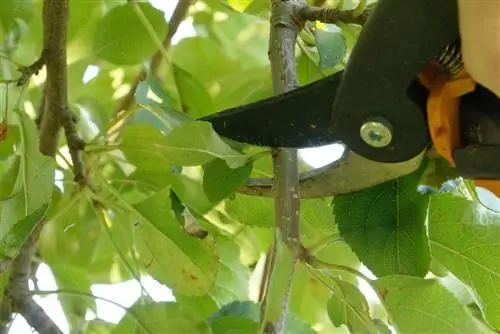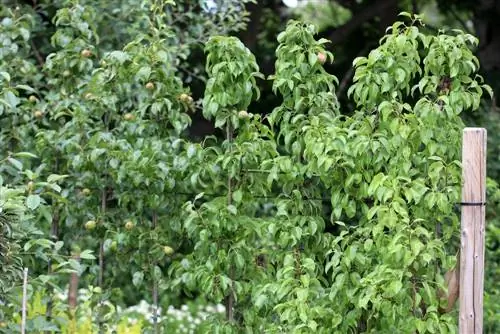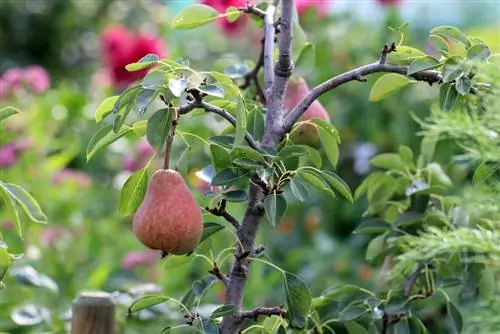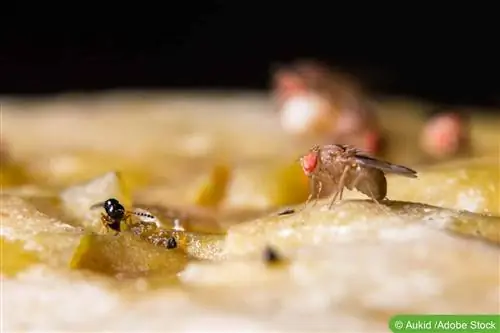- Author admin [email protected].
- Public 2023-12-17 03:39.
- Last modified 2025-01-24 12:45.
The nightmare in the garden is called fruit tree cancer. Apple and pear trees are primarily affected by the fungal disease. Other deciduous trees are also in the crosshairs of the sinister pathogens. To prevent the disease from gaining the upper hand, home gardeners should be familiar with characteristic symptoms. Read this guide on how to correctly identify fruit tree cancer. This is how you can successfully fight the fungal disease.
Interesting facts
Fruit tree cancer is a plant disease widespread worldwide. The infection is caused by the pustular fungus Neonectria ditissima. In the advanced stage, the wood and bark tissue dies. The affected tree then covers the infection site with wound tissue. The process can be recognized by voluminous callus growths that are reminiscent of cancerous tumors.
Fruit trees are most commonly affected, which is what the name refers to. The fungal pathogens primarily attack the cultivated apple (Malus domestica) and some crabapple varieties. Furthermore, the cunning fungal spores have their sights set on cultivated pears (Pyrus communis). To make matters worse, popular ornamental trees are also not spared, such as alder (Alnus), beech (Fagus), holly (Illex), birch (Betula), ash (Fraxinus), poplar (Populus) and walnut (Juglans). Due to the wide range of host plants, the disease is often referred to as tree canker. However, the tumors are not cancer in the medical sense.
Symptomatic framework conditions
Fruit canker is a headache for private and commercial gardeners around the world. Of course, profound damage can only be feared under certain conditions. The fungal pathogens rely on a specific climate in order to be able to spread to a destructive extent. The following list summarizes the mandatory framework conditions:
- Temperatures between 11 and 16 degrees every day for more than 8 hours for half a year
- Significant rainfall on at least 55 days within this window
Rainy regions in Germany offer tree cancer an ideal environment, such as the North German Plain or the Rhineland with the rainy metropolis of Mönchengladbach.
The pathogen is a wound parasite

The fungal pathogen of fruit tree cancer acts as a wound parasite. As a result, the pustule fungi rely on injuries to their host trees in order to get into the plant tissue via this route. The parasites do not distinguish between young and old wood. Common entry points of natural origin are hailstorms, frost cracks and storm damage. Numerous sucking and feeding insects also promote the disease. Last but not least, pruning fruit and other deciduous trees leaves large wounds that serve as a target for fungal spores Neonectria ditissima. If the leaf and fruit stalks are exposed after harvest or leaf fall, the pathogens of tree cancer are not far away.
Symptoms on wood
The window of opportunity for the main infection in Central Europe is long, from the beginning of fruit blossom until well into November. It is advisable to keep an eye out for symptoms of fruit tree canker infection from early spring to late fall. The earlier you detect the disease, the more effective countermeasures will be. Immediately after landing on the entry site, the mushrooms germinate and can no longer deny their presence. How to identify an infestation:
- Tiny, light brown, sunken spots on the bark
- Often in close proximity to an eye
- Infected areas dry out and turn reddish brown to dark brown
- Rapid enlargement of the infection site until the bark bursts
As it progresses, the disease gradually spreads throughout the entire branch. Within the following weeks, clearly visible, light-colored spore deposits form in the area of the dead bark. By next spring at the latest, you will be able to clearly recognize the canker infection through spherical, red fruiting bodies with a diameter of 0.5 mm.
If the infection causes larger wounds on the bark and wood, the affected tree takes countermeasures. It activates its callus tissue to close the infection sites. The tumor-like swellings form, which is why fruit tree cancer gets its name. Unfortunately, the sick tree is fighting a losing battle. In this way, neither a cure nor the further spread can be prevented.
Tip:
An important indication of fruit tree cancer is withered branches in certain parts of the crown. The water and nutrient supply comes to a standstill where infected tissue dies. Unexplained drying of individual shoots is a reason to examine the tree more closely for common symptoms, such as light to reddish fruit bodies or cracked bark.
Signs of illness on fruits
In addition to the wood, the fruits on the fruit tree can be affected. Often the flower dies immediately or a small fruit set develops. The first symptoms appear on an infected fruit from the end of June, when it has reached about half of its final size. You can now see dying tissue in the calyx area. From there, the whitish fungal mycelium spreads over the entire surface of a fruit. From there the fungal threads work their way into the core. Characteristics of precocity then appear.
If the pustule fungi only strike later in the year, the infection begins in the last four weeks before the harvest time. You only notice the symptoms during harvesting work. The infected tissue is sharply separated from the he althy pulp, which does not go unnoticed by an attentive observer. A simple test provides ultimate certainty. These are symptoms of fruit tree cancer if you can cleanly separate the affected pulp with a spoon and minimal pressure.
Fighting fruit tree cancer
Effective fungicides against fruit tree cancer are only approved for commercial cultivation. Nevertheless, home gardeners and their trees are not defenseless against the dreaded fungal infection. A professional cut into he althy wood has proven to be an effective control method. The sooner you recognize the symptoms, interpret them correctly and act consistently, the better the chances of recovery. On older trees, individual branches are usually affected, meaning the tree will continue to live for many years. How to do it right:
- The best time is on a mild day in late winter with dry weather
- Sharpen scissor blades, replace dull saw blades
- Important: Carefully clean and disinfect cutting before and after
- Cut in he althy wood areas with a slight angle so that rainwater runs off better
A sharply defined transition between diseased and he althy tissue simplifies the search for the right interface. Smooth the cut with a knife. Finally, apply a thin layer of wound closure agent to the edges of the wound.
Tip:
Cuttings infected with fruit tree canker are a dangerous source of renewed infections for up to two years. Under no circumstances should you dispose of shoots and branches in the compost or in organic waste. Ideally, you burn the wood or dispose of the clippings in the municipal composting facility.
Tips for prevention

In the sustainable prevention of fruit tree cancer, expert pruning care plays a key role. When choosing a location, injuries caused by wind breakage should be ruled out. Good soil quality and a balanced supply of nutrients strengthen the defenses of deciduous trees so that they can fend off attacking fungal spores on their own. The following overview summarizes tried and tested methods of preventing tree cancer:
- Never carry out tree pruning in damp weather or on damp wood
- Don't leave long cones
- Cut branches to buds and thick branches on astring
- Thin out steep slotted branches to avoid friction and water accumulation at the fork
- Avoid mechanical injuries, such as loose binding material or rubbing branches
- If there is a risk of frost cracks, protect the trunk with white paint
- Fertilize organically with compost
- No nitrogen-rich nutrient supply with artificial fertilizers
- Plant fruit trees in a wind-protected location with loose, permeable soil without the risk of waterlogging
Statistical studies have shown that contaminated pruning shears and saws are among the main vectors of plant diseases. Please clean the cutting tool thoroughly before and after a cut and disinfect blades and saw blades with alcohol, cleaning spirit or Sagrotan.
Resistant and susceptible varieties
You will look in vain for varieties that are completely resistant to fruit tree cancer. However, some apple varieties have proven to be particularly resilient in private and commercial cultivation. Other varieties have been found to be explicitly susceptible. We have put together well-known names for both variants:
Resistant
- Topaz
- Beautiful from Boskoop
- Pinova
- Santana
- Jonagold
- Elstar
Vulnerable
- Braeburn
- Cox Orange
- Discovery
- Gloster 69
- Gala
- Clear Apple
- Oldenburg
- Idared
The popular Golden Delicious apple variety is said to have a medium susceptibility to fruit tree cancer. The same applies to a traditional variety from the “Altes Land” growing region called Ingrid-Marie.






